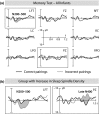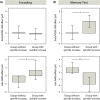The reciprocal relation between sleep and memory in infancy: Memory-dependent adjustment of sleep spindles and spindle-dependent improvement of memories
- PMID: 30160012
- PMCID: PMC6585722
- DOI: 10.1111/desc.12743
The reciprocal relation between sleep and memory in infancy: Memory-dependent adjustment of sleep spindles and spindle-dependent improvement of memories
Abstract
Sleep spindle activity in infants supports their formation of generalized memories during sleep, indicating that specific sleep processes affect the consolidation of memories early in life. Characteristics of sleep spindles depend on the infant's developmental state and are known to be associated with trait-like factors such as intelligence. It is, however, largely unknown which state-like factors affect sleep spindles in infancy. By varying infants' wake experience in a within-subject design, here we provide evidence for a learning- and memory-dependent modulation of infant spindle activity. In a lexical-semantic learning session before a nap, 14- to 16-month-old infants were exposed to unknown words as labels for exemplars of unknown object categories. In a memory test on the next day, generalization to novel category exemplars was tested. In a nonlearning control session preceding a nap on another day, the same infants heard known words as labels for exemplars of already known categories. Central-parietal fast sleep spindles increased after the encoding of unknown object-word pairings compared to known pairings, evidencing that an infant's spindle activity varies depending on its prior knowledge for newly encoded information. Correlations suggest that enhanced spindle activity was particularly triggered, when similar unknown pairings were not generalized immediately during encoding. The spindle increase triggered by previously not generalized object-word pairings, moreover, boosted the formation of generalized memories for these pairings. Overall, the results provide first evidence for a fine-tuned regulation of infant sleep quality according to current consolidation requirements, which improves the infant long-term memory for new experiences.
Keywords: consolidation; generalization; learning; memory; sleep; sleep spindles.
© 2018 The Authors. Developmental Science Published by John Wiley & Sons Ltd.
Figures






Similar articles
-
The Sleeping Infant Brain Anticipates Development.Curr Biol. 2017 Aug 7;27(15):2374-2380.e3. doi: 10.1016/j.cub.2017.06.070. Epub 2017 Jul 27. Curr Biol. 2017. PMID: 28756948
-
Sleep Spindles Promote the Restructuring of Memory Representations in Ventromedial Prefrontal Cortex through Enhanced Hippocampal-Cortical Functional Connectivity.J Neurosci. 2020 Feb 26;40(9):1909-1919. doi: 10.1523/JNEUROSCI.1946-19.2020. Epub 2020 Jan 20. J Neurosci. 2020. PMID: 31959699 Free PMC article.
-
Sleep Spindles Preferentially Consolidate Weakly Encoded Memories.J Neurosci. 2021 May 5;41(18):4088-4099. doi: 10.1523/JNEUROSCI.0818-20.2021. Epub 2021 Mar 19. J Neurosci. 2021. PMID: 33741722 Free PMC article.
-
The function of the sleep spindle: a physiological index of intelligence and a mechanism for sleep-dependent memory consolidation.Neurosci Biobehav Rev. 2011 Apr;35(5):1154-65. doi: 10.1016/j.neubiorev.2010.12.003. Epub 2010 Dec 16. Neurosci Biobehav Rev. 2011. PMID: 21167865 Review.
-
Spindle-dependent memory consolidation in healthy adults: A meta-analysis.Neuropsychologia. 2023 Oct 10;189:108661. doi: 10.1016/j.neuropsychologia.2023.108661. Epub 2023 Aug 17. Neuropsychologia. 2023. PMID: 37597610 Review.
Cited by
-
Nonrapid eye movement sleep characteristics and relations with motor, memory, and cognitive ability from infancy to preadolescence.Dev Psychobiol. 2021 Dec;63(8):e22202. doi: 10.1002/dev.22202. Dev Psychobiol. 2021. PMID: 34813099 Free PMC article. Review.
-
Sleep spindle maturity promotes slow oscillation-spindle coupling across child and adolescent development.Elife. 2023 Nov 24;12:e83565. doi: 10.7554/eLife.83565. Elife. 2023. PMID: 37999945 Free PMC article.
-
Developing customized NIRS-EEG for infant sleep research: methodological considerations.Neurophotonics. 2023 Jul;10(3):035010. doi: 10.1117/1.NPh.10.3.035010. Epub 2023 Sep 25. Neurophotonics. 2023. PMID: 37753324 Free PMC article.
-
Sleep's role in updating aversive autobiographical memories.Transl Psychiatry. 2022 Mar 24;12(1):117. doi: 10.1038/s41398-022-01878-1. Transl Psychiatry. 2022. PMID: 35332136 Free PMC article.
-
Development of the N400 for Word Learning in the First 2 Years of Life: A Systematic Review.Front Psychol. 2021 Jun 30;12:689534. doi: 10.3389/fpsyg.2021.689534. eCollection 2021. Front Psychol. 2021. PMID: 34276518 Free PMC article.
References
-
- Bergmann, T. O. , Mölle, M. , Diedrichs, J. , Born, J. , & Siebner, H. R. (2012). Sleep spindle‐related reactivation of category‐specific cortical regions after learning face‐scene associations. NeuroImage, 59(3), 2733–2742. - PubMed
-
- Bódizs, R. , Kis, T. , Lázár, A. S. , Havrán, L. , Rigó, P. , Clemens, Z. , & Halász, P. (2005). Prediction of general mental ability based on neural oscillation measures of sleep. Journal of Sleep Research, 14(3), 285–292. - PubMed
-
- Clemens, Z. , Fabo, D. , & Halasz, P. (2005). Overnight verbal memory retention correlates with the number of sleep spindles. Neuroscience, 132(2), 529–535. - PubMed
-
- De Gennaro, L. , & Ferrara, M. (2003). Sleep spindles: An overview. Sleep Medicine, 7(5), 423–440. - PubMed
Publication types
MeSH terms
LinkOut - more resources
Full Text Sources
Other Literature Sources
Research Materials

